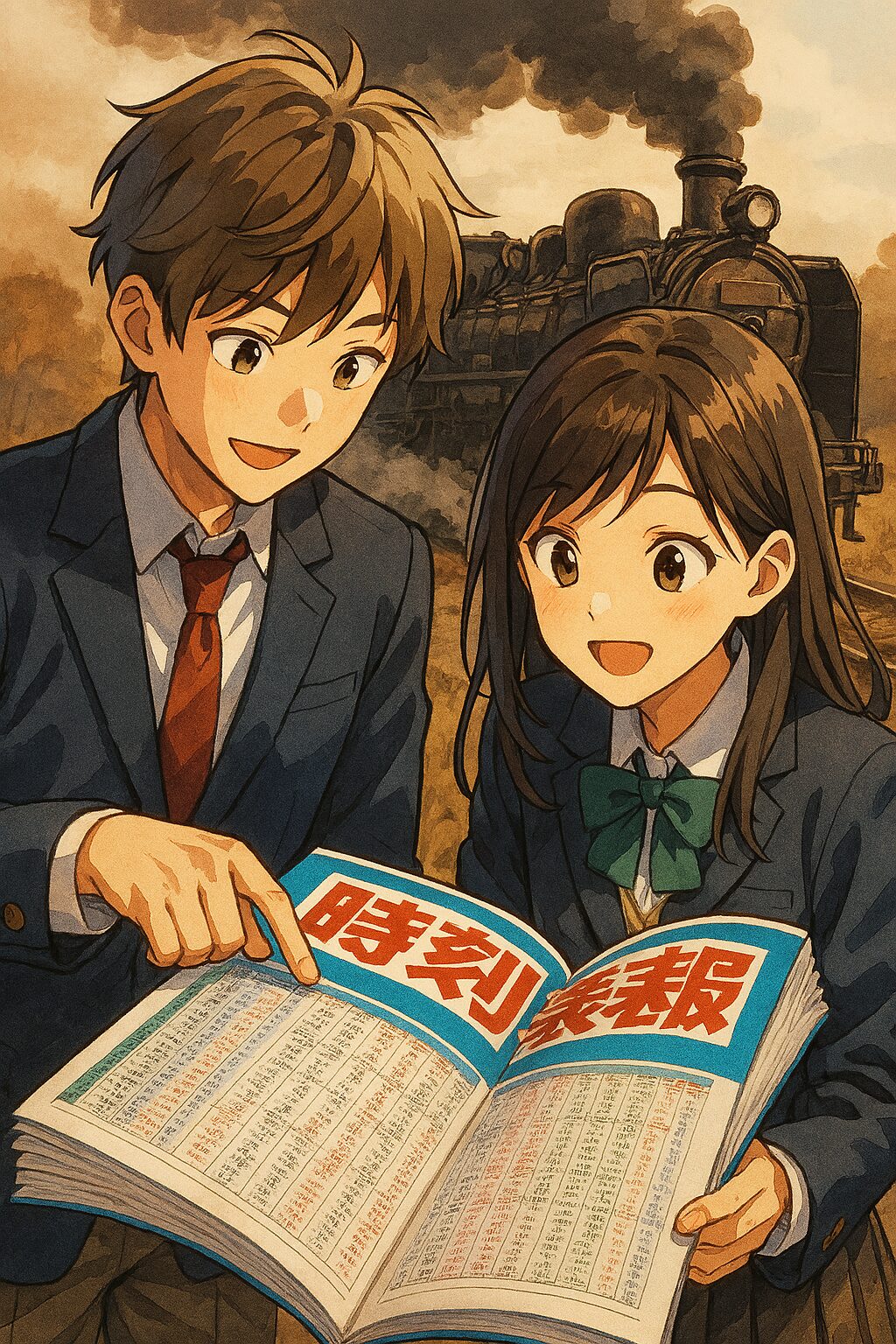This commemorative day, Timetable Day (Jikokuhyou Kinenbi), marks the anniversary of the first publication of Japan’s full-fledged monthly timetable, the “Kisha Kisen Ryokō Annai” (Railroad and Steamship Travel Guide), by the Kōin Shinshi publishing company in 1894 (Meiji 27). More than just a transport guide, this publication embodies the spirit and culture of Japan’s modernization. We will introduce our international readers to the profound history and cultural essence we can deduce from this key piece of Japanese history.
- October 5th, Timetable Day: The Booklet that Embodies Japan’s Meticulous Modernization
- 10月5日 時刻表記念日:日本の緻密な近代化を体現する一冊
October 5th, Timetable Day: The Booklet that Embodies Japan’s Meticulous Modernization
History: A Revolutionary Publication that Mastered “Time” and “Travel” in Modern Japan
In the latter half of the 19th century, Japan, having ended its period of isolation, rapidly embarked on the path of modernization. The railway, imported from the West, was central to this transformation. Following the opening of the Shinbashi-Yokohama line in 1872 (Meiji 5), rail lines quickly extended across the nation. As this new mode of transportation became widespread, the public began to demand accurate operating information—the “timetable.”
The man who answered this call was the entrepreneur Tezuka Takemasa, acting on the advice of the intellectual leader Yukichi Fukuzawa. Using the timetables from Britain, the birthplace of the railway, as a reference, Tezuka launched the groundbreaking Kisha Kisen Ryokō Annai.
What made this early timetable particularly notable was that it did not simply list departure times and fares. It included tourist information and travel essays about the areas along the routes, making it both a practical guide for planning trips and a literary work that stirred people’s wanderlust.
Although the timetable of that era differed from today’s—using vertical Kanji script read from right to left—there is no doubt that it laid the foundation for time management and accuracy in Japan’s transportation system. With its publication, the Japanese perception of travel shifted from “approximate time” to “minute-by-minute accuracy,” establishing the basis for Japan’s world-class on-time performance.
Culture: The Spirit of Discipline and Consideration for Others Within the Timetable
The timetable holds a significance in Japanese culture that goes beyond a mere printed paper. It is the embodiment of the Japanese people’s collectivism and their passion for precision.
1. The DNA of Punctuality
The reason Japanese railways are hailed as the “world’s most punctual” is deeply rooted in the spirit of punctuality symbolized by the timetable. Announcements apologize for delays of mere minutes, and “delay certificates” are sometimes issued because running on time is a shared societal norm. This disciplined attitude permeates not only the railway system but all aspects of business and daily life. The timetable is, in essence, the “blueprint” that supports the **entire social trust system**.
2. The Culture of “Trip Planning”
The act of deciphering a timetable is also an integral part of Japan’s travel culture. Unfolding a huge, detailed timetable, tracing the complex routes and times, and planning the optimal transfers is akin to the pleasure of solving an **intellectual puzzle**. This “joy of planning the journey” is often considered as important as the experience at the destination itself. While international readers might be surprised by the thickness of Japanese timetables, this reflects the vastness of the railway network and the passion to control it perfectly.
3. The Spirit of “Omotenashi” and Detailed Information
Just as the first timetables included travel essays and local guides, modern timetables and station signage are rich with the spirit of Omotenashi (wholehearted hospitality), designed to ensure users can travel comfortably and without getting lost. Every piece of information—car number locations, platform numbers, women-only car sections, and elevator locations—is detailed with **meticulous precision**. This reflects a deep **consideration for others**, aiming to **minimize user anxiety** and guarantee smooth travel.
Conclusion: Incorporate the “Timetable Spirit” into Your Own Travels
Timetable Day is a uniquely Japanese commemorative day, where Japan’s technological prowess and cultural discipline intersect.
Through this day, we can reaffirm the value that time is not just a flow, but a shared asset for building social trust and order. It makes us deeply consider how the accuracy of a single train time supports the daily lives and businesses of so many people.
Now, dear readers, how do you feel after learning about the meticulousness of the Japanese timetable?
How does the perception of time and the nature of public transportation in your country differ from that in Japan? How might you incorporate this “passion for accuracy” into your own daily life, work, or perhaps your next travel plan? We encourage you to look at your city’s public transport schedule with a slightly different perspective after reading this article. It contains more than just a list of numbers; it holds the **efforts and hopes of countless people**.
Useful External Links
- East Japan Railway Cultural Foundation
http://www.ejrcf.or.jp/ - The Railway Museum
https://www.railway-museum.jp/ - JTB Timetable (JTB Publishing)
https://jtbpublishing.co.jp/
日本が世界に誇る「正確さ」と「緻密さ」の象徴、10月5日は時刻表記念日です。
この記念日は、1894年(明治27年)のこの日に、庚寅新誌社から日本初の本格的な月刊時刻表『汽車汽船旅行案内』が発行されたことに由来します。単なる交通の案内書に留まらない、日本の近代化の精神と文化を凝縮したこの出版物の歴史と、そこから読み解くべき日本文化の神髄を、海外の読者の皆様にご紹介します。
10月5日 時刻表記念日:日本の緻密な近代化を体現する一冊
歴史:近代日本の「時」と「旅」を掌握した革命的な出版物
19世紀後半、鎖国を解いた日本は急速な近代化の道を歩み始めました。その中核を担ったのが、欧米から導入された鉄道です。1872年(明治5年)の新橋・横浜間の鉄道開通を皮切りに、鉄路は瞬く間に全国へと延伸していきました。しかし、新しい交通手段が普及するにつれて、人々は正確な運行情報、つまり「時刻表」を求め始めます。
この需要に応えたのが、福沢諭吉の勧めを受けた実業家、手塚猛昌でした。手塚は鉄道発祥の地イギリスの時刻表を参考に、当時としては画期的な『汽車汽船旅行案内』を創刊しました。
この初期の時刻表の特筆すべき点は、単に発車時刻や運賃を羅列するだけではなかったことです。沿線の観光案内や紀行文までが掲載されており、旅の計画を立てるための実用書であると同時に、人々の旅情を掻き立てる読み物としての側面も持っていました。
当時の時刻表は、現在のものとは異なり、漢字の縦書きで右から左へ読み進める形式でした。しかし、この一冊が日本の交通システムにおける時間管理と正確性の基盤を築いたことは疑いようがありません。この出版を機に、日本人の移動に対する考え方は「ざっくりとした時間」から「分単位の正確さ」へと大きく変貌し、後の世界に冠たる日本の定時運行の基礎が確立されたのです。
文化:時刻表に宿る「規律」と「他者への配慮」の精神
時刻表は、単なる紙の印刷物以上の意味を日本文化の中で持っています。それは、日本人の集団主義と正確さへの偏愛の結晶です。
1. 「時間厳守」のDNA
日本の鉄道が「世界一正確」と称される背景には、この時刻表が象徴する時間厳守の精神が深く根付いています。列車が数分遅れるだけで謝罪のアナウンスが入り、時には「遅延証明書」が発行されるのは、時間通りに運行することが社会全体の共通規範となっているからです。この規律正しい態度は、鉄道だけでなく、ビジネスや日常生活のあらゆる側面に浸透しています。時刻表は、社会全体の信頼システムを支える「設計図」なのです。
2. 「旅の計画」という文化
時刻表を読み解く行為は、日本の旅文化の一環でもあります。巨大で緻密な時刻表を広げ、複雑に絡み合う路線と時間を読み解き、最適な乗り換えを計画することは、ある種の知的なパズルを解く喜びにも似ています。この「旅を計画する楽しみ」は、旅先での体験と同じくらい重要視されます。海外の読者の中には、日本の時刻表の分厚さに驚く方もいるかもしれませんが、それは日本の鉄道網の広大さと、それを完璧に制御しようとする情熱の表れなのです。
3. 「おもてなし」の心と細やかな情報
初期の時刻表が紀行文や沿線案内を掲載していたように、現代の時刻表や駅の案内表示にも、利用者がいかに快適に、迷うことなく移動できるかを考えたおもてなしの精神が色濃く反映されています。車両の連結位置、ホームの号車案内、女性専用車両やエレベーターの位置など、あらゆる情報が細部にわたって記載されています。これは、利用者の不安を最小限に抑え、スムーズな移動を保障しようとする、他者への深い配慮の表れです。
結び:あなたの旅の計画にも「時刻表精神」を
時刻表記念日は、日本の技術力と文化的な規律が交差する、極めて日本的な記念日です。
私たちはこの日を通して、時間とは、単なる流れではなく、社会の信頼と秩序を築くための共有財産であるという価値観を再認識することができます。そして、たった一つの列車時刻の正確さが、どれほど多くの人々の日常生活やビジネスを支えているかを深く考えさせられます。
さて、読者の皆様は、日本の時刻表の緻密さに触れて、どのように感じたでしょうか?
あなたの国では、時間に対する考え方や公共交通機関のあり方は、日本と比べてどのような違いがありますか?この「正確さへの情熱」を、あなたの日常生活や仕事、あるいは次の旅の計画に、どのように活かしてみたいと思いますか。是非、この記事を読んだ後、あなたの街の時刻表を少し違った視点で眺めてみてください。そこには、単なる数字の羅列以上の、人々の営みと願いが詰まっているはずです。
参考になる外部リンク
- 公益財団法人 東日本鉄道文化財団 (East Japan Railway Cultural Foundation)
http://www.ejrcf.or.jp/ - 交通博物館(鉄道博物館)(The Railway Museum)
https://www.railway-museum.jp/ - JTB時刻表 (JTB Timetable)
https://jtbpublishing.co.jp/



コメント